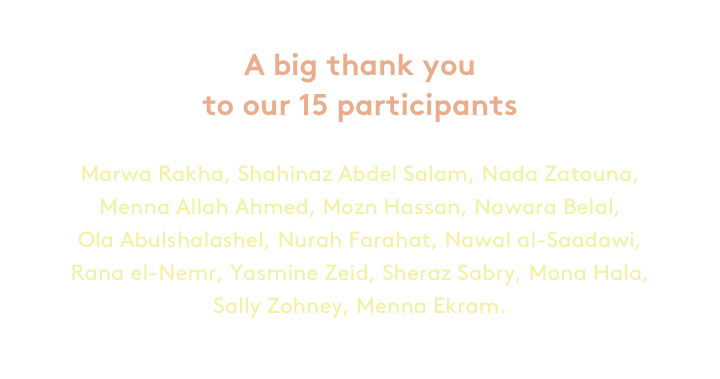What's the project?
ما هو المشروع؟
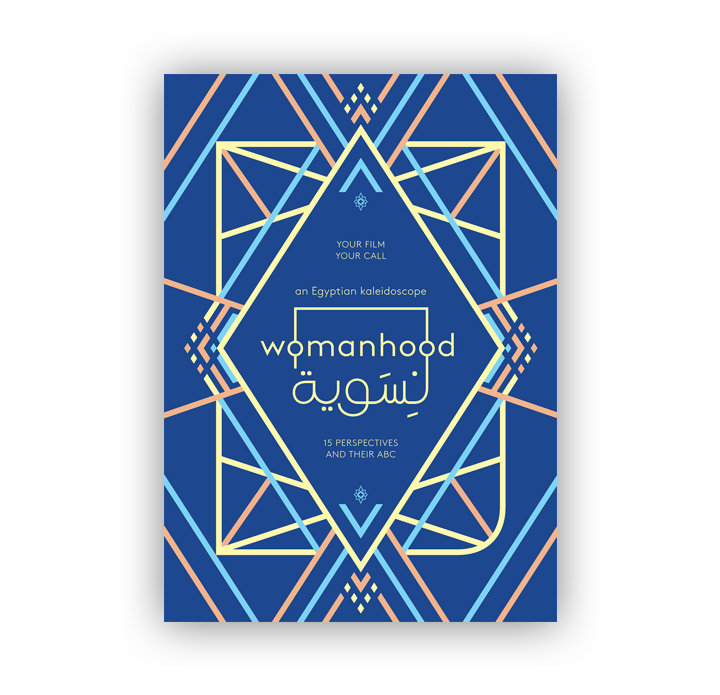
How did we get this idea?
كيف توصلنا لهذه الفكرة؟
The starting point of this project
نقطة بداية هذا المشروع
"OK. This is when I get really angry. I’m Egyptian, and I’m a woman. I have been engaged in the political process, if we can say so. Definitely, after 2011 or during 2011. And the amount of questions, and interviews, and discussions I’ve been asked, about being a woman, in Egypt, about the Revolution, is completely ridiculous, absurd and ignorant."
Sally, Cairo, April 2015.
Sally’s exasperation is the starting point of this project. This anger is triggered by the expected questions, heard over and over, when the West proclaims to represent Egyptian women’s voices. This reaction is what prompted the very idea of this interactive documentary. Working on the notion of Gender quickly reveals the need to seek new ways to listen to social actors and to represent women’s "world views".
In the current context, where some Western framings convey ethnocentric generalizations, we tried to find a medium that does not lock into orientalist stereotypes. The flexibility of the interactive documentary format hence highlights the subtlety and the plurality of these individual perspectives.
Our initiative is therefore to collect the testimonies of Egyptian women while engaging in a documentary narrative written by the protagonists themselves. In 2015, in Cairo, 15 women built their own interactive ABC around Gender.
Five years after the Egyptian Revolution, Womanhood is a web platform where Sally, Nawara, Mozn, Shiraz and others tackle a diversity of topics, while tearing down reductive readings.
"هنا بغضب، أنا مصرية وست واشتركت في العملية السياسية، لو ينفع نسميها كده، طبعا بالذات بالذات بعد ٢٠١١ أو خلال ٢٠١١ وكمية الأسئلة و المقابلات والمناقشات اللي اتسألت فيها عن كوني ست مصرية والثورة، حاجة سخيفة وعبثية وجاهلة." سالي، القاهرة، إبريل ٢٠١٥.
غضب سالي هو نقطة بداية هذا المشروع. ينتج هذا الغضب بسبب تكرار أسئلة متوقعة عندما يدعي الإعلام الغربي أنه يمثل أصوات النساء المصريات. كان هذا رد الفعل ما أثار فكرة هذا الفيلم التسجيلي التفاعلي. يكشف العمل على مفهوم الجندر، الحاجة لإيجاد طرق جديدة للاستماع وتمثيل نظرة النساء للعالم.
في السياق الحالي حيث تنقل بعض الأطر الغربية تعميمات تتمحور حول العرق، حاولنا إيجاد وسيط لا ينحصر في أنماط استشراقية. تبرز مرونة الفيلم التسجيلي التفاعلي تعدد تلك الرؤى الشخصية.
ولذلك بادرنا بجمع شهادات نساء مصريات والاهتمام بسرد تسجيلي يخلقه أبطاله. في عام ٢٠١٥ في القاهرة، ١٥ أمرأة خلقن سردياتهن الأبجدية حول مفهوم الجندر.
خمس سنوات بعد الثورة المصرية، نسوية نظام على الانترنت حيث تتناول سالي ونوارة ومزن وشيراز وغيرهن مواضيع مختلفة ويتخلصن من السرديات المختزلة.
Fieldwork and Feedback
البحث الميداني وردود الأفعال
Before filming this interactive documentary, I first met some of its participants in 2012 in Cairo while doing fieldwork for my Master’s dissertation at the EHESS (School for Advanced Studies in the Social Sciences, Paris). This historical and anthropological research was written under the guidance of Jocelyne Dakhlia and was centered on women’s autobiographies - memoirs and blogs - in Egypt from 1899 to 2012. When requesting interviews with authors and bloggers for this study, I introduced myself as a French student analyzing the writing of the feminine "I" in Egypt: this situated my standpoint and affected the themes they chose to bring up. During these interviews, every female writer I spoke with expressed a general form of fatigue concerning the way in which the West was portraying their voices - or their supposed lack of voice.
When talking about the Western gaze on the Middle East, they often invoked Edward Said’s work on Orientalism (Said 1978) to criticize the "othering" process still coming from the West. The orientalist approach, that Said details, operates along a clear split between an Occidental "modern us"/ Oriental "backwards them". Such a narrative also implies a patronizing hierarchy, and therefore a form of domination. Moreover, as the anthropologist Lila Abu-Lughod (1991: 476) pointed out, such a narrative too often hides behind the notion of "culture" to convey an image of "homogeneity", and of "timelessness", especially when it comes to women in the MENA region. For each historical period all would be represented under the same simplistic avatar.
This process of domination also has precise effects on the given images of Arab womanhood. When it came to the Western representation of "the Arab woman", many interviewees brought up their weariness of being reduced to the notion of an image, as avatars emptied of their complexity, of their historical background, reduced to a few stereotypes, a few empty figures.
Since the 2011 revolution, that Western gaze has shifted more and more towards the Middle East, engendering the growing anger mentioned by Sally towards the generalizing orientalist fetish. This project is an attempt to go beyond such sweeping generalizations and simplistic narratives.
Before detailing our project’s response to this orientalism, it seemed interesting to first analyze the roots and impact of this narrative. Who are these figures built by orientalist narratives? How have the voices of Arab women been represented by the Western gaze from the end of the 18th century to present day?
قبل تصوير هذا الفيلم التسجيلي التفاعلي، قابلت أولا بعض المشاركات عام ٢٠١٢ وأنا أعمل على البحث الميداني لرسالتي للماجستير في جامعة الدراسات العليا في علوم الاجتماع في باريس. كُتب هذا البحث التاريخي والأنثروبولوجي تحت إشراف جوسلين داخليا وكان يتمحور حول سير النساء الذاتية (مدونات ومذكرات) في مصر منذ عام ١٨٩٩ حتى ٢٠١٢. عند طلبت إجراء مقابلات مع بعض الكتاب ومدونين لتلك الدراسة، قدمت نفسي كطالبة فرنسية تحلل “الأنا” المؤنثة في مصر: مما حدد موقعي وأثر على المواضيع التي اخترن طرحها. خلال مقابلاتي مع تلك الكاتبات عبرن إحساس بالإجهاد من الطريقة التي كان يصور الإعلام الغربي أصواتهن أو غياب أصواتهن المفترض.
عندما تحدثن عن نظرة الغرب للشرق الأوسط كن يذكرن عمل إدوارد سعيد “الاستشراق” سعيد (١٩٧٧) لنقد عملية “صناعة الآخر” من قبل الغرب. النهج الاستشراقي للغرب يعمل من خلال خلق فصل ما بين "النحن الحديثين”/الغرب و “هم المتخلفين”/الشرق. هذا السرد يشير إلى هرمية سلطوية وبالتالي شكل من أشكال السيطرة. علاوة على ذلك، أوضحت عالمة الأنثروبولوجيا ليلى أبو لغد أن تلك السرديات كثيرا ما تختبئ وراء مفهوم “الثقافة” لتنقل صورة “تجانس” و “أزلية” فيما يخص النساء في منطقة الشرق الأوسط.
عمليات السيطرة تلك لها تأثير على الصور النسوية العربية المقدمة. فيما يخص صورة النساء العربيات، أثار الكثير من المُقابلات احساسهم بالسأم من اختزالهن لصورة وتجسيدات مفرغة من التعقيد والخلفية التاريخية واختزالهن لبضعة أنماط وبضعة شخصيات فارغة.
انتقلت نظرة الغرب نحو الشرق الأوسط بعد ثورة ٢٠١١ والنتيجة هي الغضب التي تحدثت عنه سالي فيما يخص التعميمات والولع الاستشراقي. يهدف هذا المشروع تخطي تلك التعميمات والسرديات المبسطة. لكن لكي نتفادى نتائجه بدا أنه من المهم تحليل جذوره. ما هي تلك الصور التي تكونت بسبب السرديات الاستشراقية؟ كيف تُصوِر النظرة الاستشراقية أصوات النساء العربيات منذ نهاية القرن الثامن عشر حتى الوقت الحالي؟
Historiography: Orientalism and Gender
التأريخ: الاستشراق و الجندر
In today’s world the adjectives "Arabic" and "Muslim" are too often understood as synonyms. In the present day, the singular is too often used to refer to "the Arab woman". As a result, it is necessary to question the Western historiography on such a topic and the chronological evolution of Western representations of "the Arab/Muslim woman". Even if our work is only focused on Egypt, much of the Western historiography has seen "the Arabic/Muslim world" as an ensemble. A critique of that Western view pushes us to examine this entire geographical fantasized space in the following research.
Three main phases unravel between Napoleon’s French Expedition to Egypt (1798-1801) and today. Indeed, Napoleon’s campaign first unlocks a fascination with "the Odalisque". Later on, the Colonial Era turns the lascivious odalisque into a passive "Victim" of the harem waiting to be saved. This image prevails over any other until "the Arab Spring" complexifies the reading of mute women: the image of "the Rebel" hence starts to emerge. These three avatars - the odalisque, the victim and the rebel - have since crystallized much of Western imagery.
في الظروف المعاصرة، كثيرا ما تفهم كلمة "عربي" و"مسلم" كأنهم نفس الشئ. وتستخدم صيغة المفرد كثيرا للإشارة "للمرأة العربية". لذلك يجب التشكيك في التأريخ الغربي والتطور الزمني لتمثيل الغربي للمرأة العربية/المسلمة. حتى وأن كان تركيزنا على مصر فإن التأريخ الغربي كان ينظر للعالم العربي والإسلامي كمجموعة واحدة. تحليل هذه الظاهرة يدفعنا لفحص المساحة الجغرافية المتخيلة بأكملها.
تنكشف ثلاث مراحل رئيسية ما بين الاحتلال الفرنسي لمصر (١٧٨٩ - ١٨٠١) ويومنا هذا. فإن الاحتلال الفرنسي في مصر أدى للافتتان "بالجارية". فيما بعد، حولت الحقبة الاستعمارية تلك الجارية الشهوانية "لضحية"، الحريم مسلوبة الإرادة التي تنتظر أن ينقذها أحد. تهيمن تلك الصورة على كل الصور الأخرى حتى فترة الربيع العربي التي عقدت أسلوب فهم صورة النساء الصامتات: هنا تبدأ صورة الثائرة في الظهور. تلك التجسيدات الثلاث، الجارية، الضحية، الثائرة، بلورت التصورات الغربية منذ ذلك الحين.
Fantasizing "the odalisque"تخيل "الجارية"
The odalisque emerges in a context of cultural productions influenced by the observers that followed Napoleon into Cairo. An orientalist artistic tradition is therefore shaped by the "Egyptomania" at work since Napoleon’s Egypt campaign. The suffix "-mania" conveys the notion of obsession and of excessiveness: this interest takes the form of a dreamlike fantasy and imagery. As the literary specialist Mohja Kahf (1999: 153) analyzes, in such visual interpretations women are often laying down in a very sensual pose, waiting for the sultan, passive and mute. The odalisque embodies that folkloric lustful harem that the Western gaze dreams of penetrating. No agency, no will power is staged when representing this "indigenous body" sensualized by the European reverie.
تظهر الجارية في سياق إنتاجات ثقافية متأثرة بالمراقبين الذين لحقوا نابليون للقاهرة. يتشكل التراث الفني الاستشراقي "بالجنون بمصر" الذي بدأ منذ حملة نابليون. كلمة الجنون تمثل الهوس والإفراط فيأخذ الاهتمام شكل التخيالات. وفقا لتحليلات مهجة خاف المتخصصة الأدبية (١٩٩٩: ١٥٣) في التعبيرات البصرية مثل تلك، كثيرا ما تكون النساء مستلقيات بشكل شهواني تنتظر السلطان، سلبية وصامتة. لا تُعرض أي إرادة أو قوة عند تمثيل ذلك الجسد "الأصلي" الحسي في المخيلة الغربية.
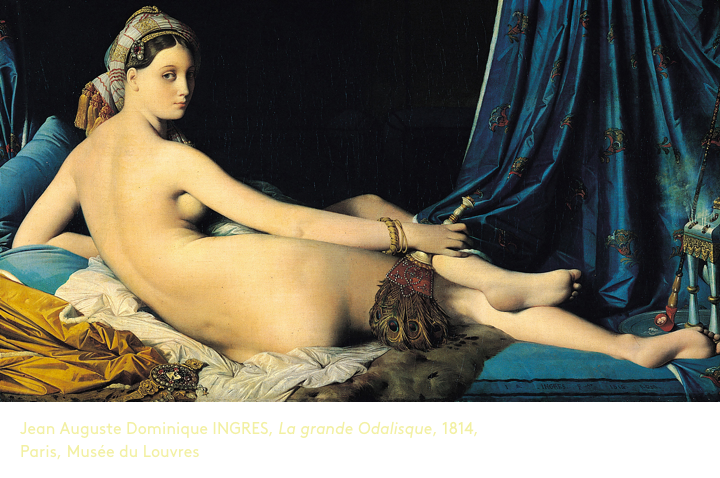
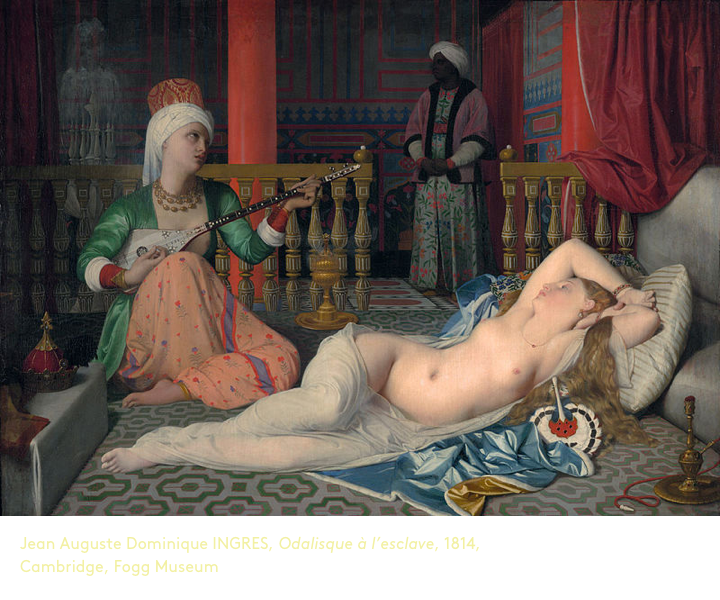
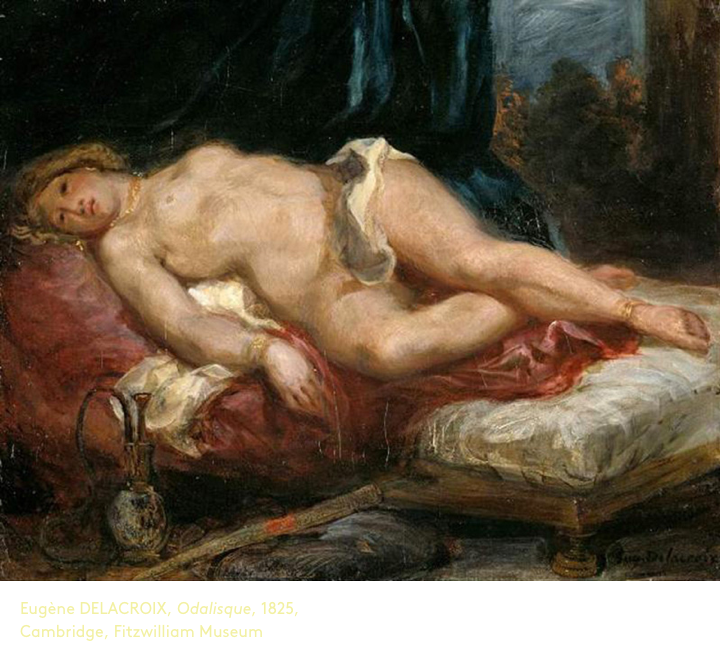
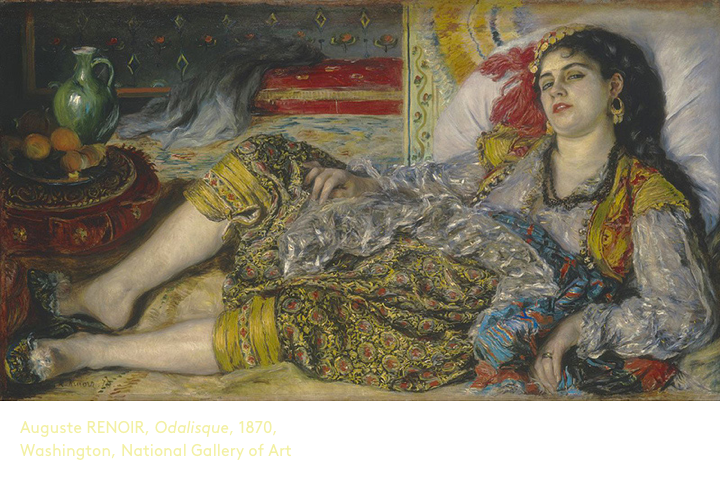
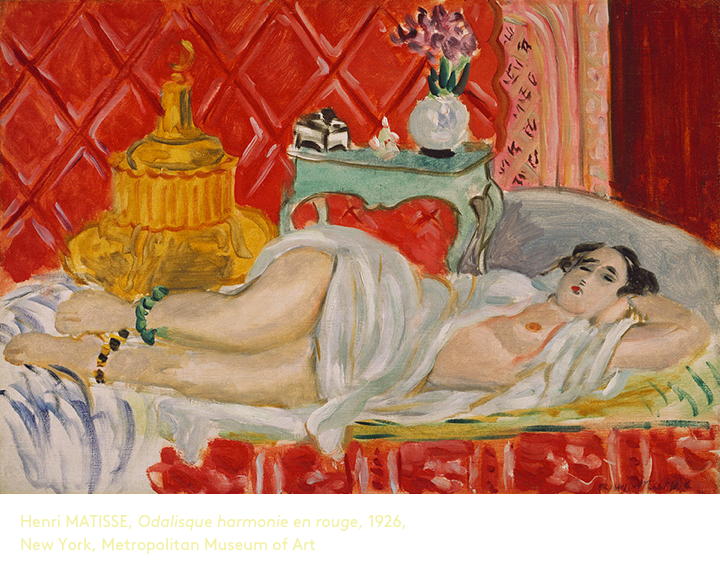
Saving "the victim"إنقاذ "الضحية"
Slowly the representation of this feminine passivity drifts from an elusive form of sensuality to an explicit form of submission. The Colonial Era shifts towards a narrative relying on the "necessity" to "save" women and to "emancipate" them. The odalisque’s erotic clothing is slowly erased from the pictorial tradition: the Western frame moves on to a focalization on the veil, seen as the ultimate symbol of women’s "oppression".
This narrative is built upon an image of women seen as "victims". This keyword is used to establish that all are supposedly dominated by the surrounding patriarchy and/or secluded by the backwardness of Islam.
In 1988, the sociologist Marnia Lazreg analyzed and criticized the "religious paradigm"(1988: 85), this Western perspective where all Arab women’s "condition" is read through the lens of a retrograde Islam. It is seen as if religion had a "privileged explanatory power over all of their lives" (1989: 756). Hence this zoom on women’s bodies: the veil becomes the very symbol of Islam’s backwardness that one must be saved from. It is therefore the so-called "civilizing" mission of colonialism that will help her escape the harem. Such a reading gives ground to the intervention of colonial power at the turn of the 20th century.
According to the literary theorist and feminist critic, Gayatri Chakravorty Spivak, the colonial ideology rests on the idea that the "white men are saving brown women from brown men" (1988: 297).
الصورة التي تمثل السلبية الأنثوية تتحول ببطء من صورة مراوغة شهوانية لشكل من أشكال الخضوع الصريح. تنفتح فترة الاحتلال على سرد يعتمد على “ضرورة” إنقاذ النساء وتحريرهن. ملابس الجارية الشهوانية التي كانت تظهر في الغرب تُمحى من التراث الفني. تصبح التصورات الغربية تركيزا على الحجاب كالرمز الأساسي لقهر النساء.
هذا السرد مبني على النظر للنساء كضحايا. تلك الكلمة مستخدمة لتأكيد أن كلهن تحت سيطرة الأبوية أو مستبعدات بسبب رجعية الإسلام.
حللت وانتقدت بالفعل مارنيا لازرغ عالمة الاجتماع في عام ١٩٨٨ “نموذج التدين" (١٩٨٨ : ٨٥). وفقا له، يرى الغرب “حالة” النساء العرب من خلال عدسة إسلام رجعي كما أن “الدين له قدرة تفسير كل جوانب حياتهن” (١٩٨٩: ٧٥٦). لذلك يتم التركيز على أجساد النساء: يصبح الحجاب هو رمز رجعية الإسلام الذي يجب أن تُنقذ منه المرأة فتصبح مهمة الاستعمار الحضارية أن تحررها من الحرملك. تلك صورة تعطي أرضية لتدخل القوى الاستعمارية في مطلع القرن العشرين.
وفقا لعالمة الأدبيات غايتاري تشاكراڤورتي شبيڤاك فإن معظم الأيديولوجية الاستعمارية مبنية على أن “الرجال البيض ينقذون النساء البنيات من الرجال البنيين” (١٩٨٨: ٢٨٧).
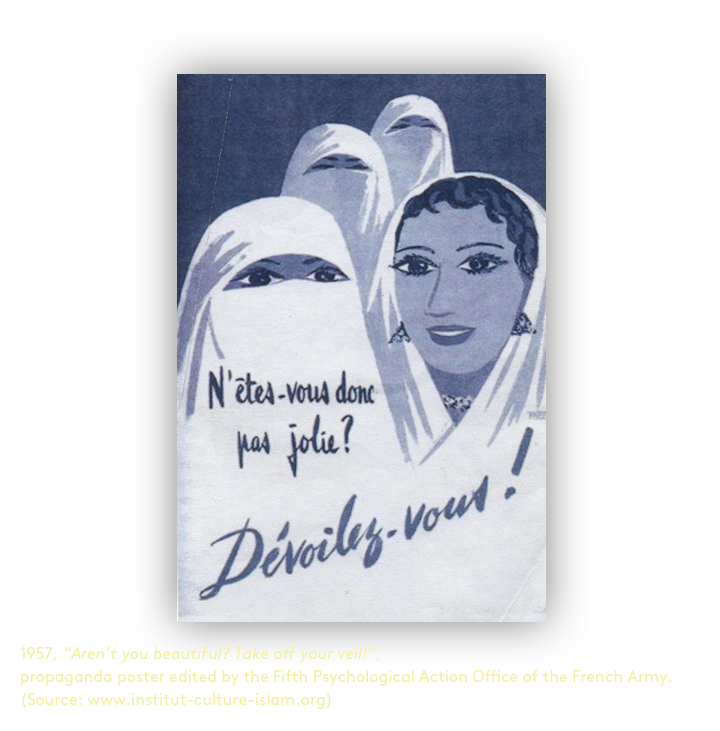
Even after the decolonization period this image is still instrumentalized by the West. In 2001, the anthropologist Lila Abu-Lughod detailed how this representation of "the victim" is still used at the turn of the 21st century to legitimize an interventionist ideology. As she points out (2001: 784), the First Lady Laura Bush, two months after September 11th, justified America’s intervention in Afghanistan by linking "Islamists" and women’s bodies, i.e. Taliban cutting of women’s nail-polished fingers. In such "to liberate" women. This narrative relies on so-called theories such as "the Clash of Civilizations" (Huntington 1996). Emphasis is put on the notion of "otherness" and representations are understood in terms of binary-oppositions led by reductionism and sweeping generalizations: "them" VS "us", "backwardness" VS "modernity", "savage" VS "civilization", "superstition" VS "science", "barbaric" VS "enlightened", "tradition" VS "modernity", "seclusion" VS "freedom".
This narrative that focalizes on "seclusion" is displayed in political stands, circulated in western media and has also shaped the social sciences in certain academic spheres. "She" is still "the Muslim woman" victim and passive, locked up in the same situation from Morocco to Pakistan… Research on "the Arab Muslim woman" continue to flourish and take this homogeneous category for granted. Women too often become the very allegory of a culture as the tensions between the notions of "tradition" and "modernity" are played upon their voices and bodies. Peter Hitchcock (2003: 102) points out that this interest in reclusion, the veil and FGM participates in an oriental fetish: it is this imagery that builds up a representation of "the victim".
This fusion between political discourse, media interest and academic research tends to simplify, hierarchize and divert attention away from the humanity, the complexity, and the diversity of personal identities. The specialist of literature and cinema Florence Martin (2011: 17) analyses the way Western feminism also too often represents "the Arab woman" or "the Muslim" woman out of any historical process or socio-economic context. The plurality of religions or the multiplicity of identifications - familial, religious, ethic, tribal, national - are too rarely considered, allowing for the "religious paradigm" to prevail.
حتى بعد حقبة الاستعمار لازال الغرب يستخدم تلك الصورة كذريعة. قالت عالمة الأنثروبولوجيا ليلى أبو لغد (٢٠٠١) أن صورة “الضحية” تلك لاتزال مستخدمة في مطلع القرن الواحد وعشرين لكي تعطي شرعية لأيديولوجيا التدخل. كما أشارت (٢٠٠١: ٧٨٤) أن السيدة الأولى لورا بوش بررت التدخل الأمريكي في أفغانستان، شهران بعد أحداث ١١ سبتمبر عن طريق ربط “الإسلاميين” بأجساد النساء أي الطالبان يقطعون أصابع النساء المزينة بطلاء الأظافر. معنى تلك الصياغة أن لازال الغرب دوره "إنقاذ" و "تحرير” و “فك أسر” النساء. يعتمد هذا السرد على نظريات مثل “صراع الحضارات” (هانتيغطون ١٩٩٦). يتم التركيز على مفهوم “الاختلاف” وتفهم التمثيلات كثنائيات متعارضة بسبب التبسيط وتعميمات مثل “نحن” ضد “هم” و “التخلف” ضد “الحداثة” و “الهمج” ضد “الحضارة” و”الخرافة” ضد “العلم” و “الوحشي” و”التنوير” و”التقاليد” ضد “الحداثة” و”العزلة” ضد “الحرية”.
تداولت هذه السردية في الإعلام الغربي وبعض الدوائر الأكاديمية والتي ظهرت في المواقف السياسية. التركيز على “العزلة” شكل أيضا العلوم الاجتماعية. لازالت “هي” “المرأة المسلمة” الضحية السلبية حبيسة نفس الأوضاع من المغرب حتى باكستان. يستمر ازدهار الأبحاث التي تركز على “المرأة العربية المسلمة” وتؤخذ تلك التصنيفات المتجانسة كمسلمات. تصبح المرأة مجازا لثقافة ويستخدم صوتها وجسدها في العلاقة المتوترة بين مفهوم “التقاليد” و”الحداثة”. كما أشار بيتر هيتشهوك (٢٠٠٣: ١٠٢) أن الاهتمام بالعزلة والحجاب وتشويه الأعضاء التناسلية للنساء يساهم في الشهوة الاستشراقية مما يبني صورة “الضحية”.
يميل اندماج الخطاب السياسي والاهتمام الإعلامي والبحث الأكاديمي، لتبسيط ووضع في ترتيب هرمي وصرف الأنظار عن إنسانية و تعقيد وتنوع الهويات الشخصية. يحلل أيضا مختص الأدب والسينما فلورنس مارتن (٢٠١١: ١٧) الطريقة التي تمثل النسوية الغربية المرأة “المسلمة” خارج أي سيرورة تاريخية أو سياق اجتماعي اقتصادي. نادرا ما يعطي اعتبار لتعدد الهويات - العائلة ، الدين، العرق ، الوطن - فيطغى النموذج الديني.
Idolizing "the rebel"تمجيد "الثائر"
Since the events - and romanticizing - of the "Arab Spring/Facebook Revolution", this monopolistic image of "the victim" has been challenged. The visibility of many women during the 2011 protests contradicts such a simplistic vision: therefore a new avatar is thus elaborated by Western media, that of the youthful "rebel". A few women become the "idols" of the revolution. The political scientist Rabab El-Mahdi mentions the Western fascination for these "small sisters" and "brothers" using "our" tools (Facebook): she observes in this Western eagerness a new form of Orientalism (El-Mahdi 2011).
منذ أحداث “الربيع العربي/ثورة الفيسبوك” والرومانسية حولها، تم تحدي تلك الصورة الاحتكارية للضحية. ظهور الكثير من النساء في مظاهرات ٢٠١١ يتعارض مع تلك الرؤية المبسطة ولذلك طوَر الإعلام الغربي تجسيد جديد في شكل الشباب “الثوري” فتصبح بعض النساء “رموز” الثورة. ذكرت أستاذة العلوم السياسية رباب المهدي هذا الافتتان الغربي “بأخواتنا الصغار” الذين يستخدمون “أدواتنا” (الفيسبوك) فهي ترى في ذلك الحماس الغربي شكل جديد للاستشراق (المهدي ٢٠١١).
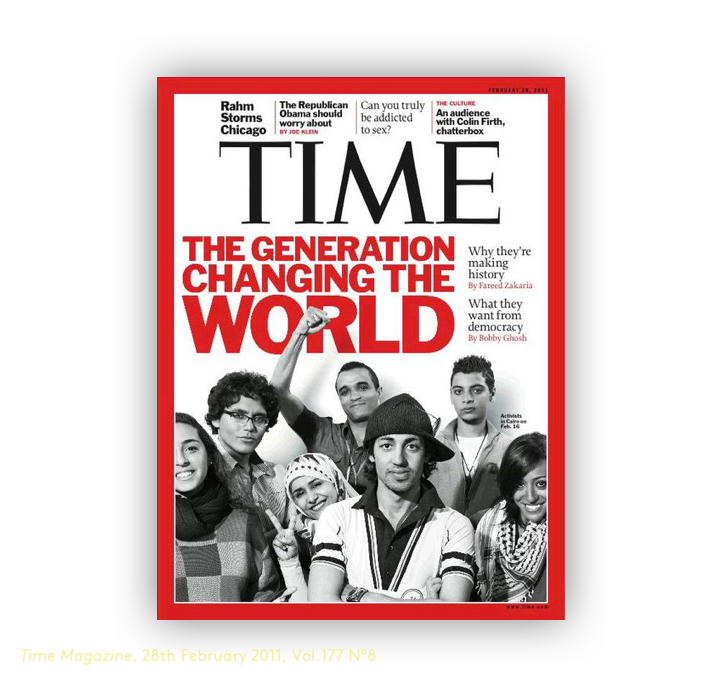
In this narrative, the media - and sometimes academia - focuses solely on the portraits of a few "modern" emancipated rebels that follow "our" steps and look like "us". This "figure" is that of a a young, connected "activist" speaking on behalf of "the victims". "The victim" doesn’t disappear from such a narrative. On the contrary, the activist and the victim coexist, the latter becoming the voiceless side of its visible counterpart.
في هذه السردية يركز الإعلام (وفي بعض الأحيان الباحثين الأكاديميين) على صور لبعض الثوار “الحديثين” المتحررين الذين يتبعون “خطواتنا” و”يشبهوننا”. هي صورة “ناشط” سياسي شاب يتحدث بالنيابة عن “الضحايا”. “الضحية” لا تختفي من السردية على العكس، الناشط والضحية يتواجدون في نفس الوقت حيث تصبح الضحية الجانب الصامت لنظيره الواضح.
The Western obsession with Arab women’s bodies carries on, but its operation within the "rebel" narrative leads to a form of sensationalism for nudity, in contrast with the ongoing veil fetish. Bodies that appear "liberated" according to certain Universalist Western readings, are celebrated and put to the forefront of feminine magazines. Such stagings insist on the transgressive dimension of their denudement. Yet this narrative continues to convey a polarization, a "like us"/ "like them" divide.
In each of these narratives - the sensual odalisque, the victim, the rebel - women’s bodies remain a battleground for identity quests between East and West. Moreover, these images often overshadow the very voices of the social actors.
يستمر الهوس الغربي بأجساد النساء العربيات ولكن عمله داخل سردية “الثوار” ينتج نوع من الحماس للعري، بالتناقض مع الهوس المستمر بالحجاب. يحتفى بالأجساد التي تبدو “متحررة” بالنسبة للقراءات الغربية ذات الميول العالمية كما أنها توضع في صدارة المجلات النسائية، تصر تلك التمثيلات على الجانب التجاوزي لعريهن لكن تظل تلك السردية تظهر استقطاب وتقسيم في شكل “مثلنا/مثلهم”.
تظل أجساد النساء في كل من تلك السرديات - الجارية، الضحية، الثائرة - ساحة معارك لمساعي هوياتية بين الشرق والغرب فضلا عن أن تلك الصور تحجب أصوات أصحابها.
Womanhood: our interactive documentary
نسوية: مشروعنا التسجيلي التفاعلي
The aim of this project is to move beyond these three images, to pay attention to women’s voices, their personal perspectives, their daily lives, their individual horizons, their emotions, their situation of utterance: in other words, to listen to their "worldviews".
Orientalism, colonialism, imperialism, and Universalist feminism tend to divide, understanding "otherness" only under comparativist terms - "progress", "modernity" being the ultimate criteria of this hierarchical process. Anthropology, in its’ "humanist"
(Lazreg 1988: 98) heritage and ideals, is the discipline devoted to hearing out differences, without operating along mechanisms of domination: paying attention to individual voices rather than merely conveying simplified images; hearing women’s "I" in a postcolonial context. Hence our desire to inscribe our work into this academic tradition. As Lila Abu-Lughod phrased it: "are there ways to write about lives so as to constitute others as less other?"
(1988: 473)
The participants and I tried to see how Visual Anthropology and Documentary Writing could answer that question. This project is not about the "Portrait of The Egyptian Woman", instead it is built by "ethnographies of the particular" (Abu-Lughod 1988: 473) as a basis for reflection on "discourses and practices", as "instruments of tactical humanism"
(Abu-Lughod 1988: 466).
Our approach was inspired by anthropological methods focusing on "discourses" and "practices": we wished to distance ourselves from the essentialism of the notion of "cultural alterity". Ethnographies of the particular, as defined by Abu-Lughod, is a method that shifts away from the problematic dimension of the notion of "culture". "By focusing closely on particular individuals and their changing relationships, one would necessarily subvert the most problematic connotations of culture: homogeneity, coherence, and timelessness."(Abu-Lughod 1988: 476)
To analyze "practices" directly refers to Bourdieu’s approach (Bourdieu 1977), while questioning "discourses" in terms of domination echoes Foucault’s work (Foucault 1978). This conceptual framework enabled us to take on a comparatist reflection putting the plurality and the diversity of our subject - womanhood- to the forefront.
Far from any positivism, this approach is inspired by the heritage of culturalist anthropologists such as Franz Boas - questioning ethnocentrism - , while staying in line with interpretivism as analyzed by Clifford Geertz - by continuing to elaborate thick descriptions (Geertz 1973). Lila Abu-Lughod invites us to "zoom in" and reach individual voices. This documentary was our audio-visual attempt to do so.
In this project, no point of view is here to be generalized: this is about the polyphony of the voices and the polysemy of the words.
يهدف مشروعنا تجاوز تلك الصور الثلاث و الإصغاء لأصوات النساء و منظوراتهن الشخصية وحياتهن الشخصية وآفاقهن ومشاعرهن والموقف وقت الحديث: بكلمة أخرى منظورهم للعالم.
يميل الاستشراق والاستعمار والإمبريالية والنسوية العالمية لتقسيم وفهم “الآخر” من خلال أطر مقارنة - “التقدم و “الحداثة” هي المعايير النهائية للعملية الهرمية. الأنثروبولوجيا بتراثها وقيمها “الإنسانية” (لازريغ ١٩٨٨:٩٨) مجال مكرس للإستماع للاختلافات بدون العمل بآليات هيمنة: الاهتمام بأصوات فردية بدلا من إظهار صور مبسطة والإستماع “للأنا” الخاصة بالنساء في سياق ما بعد الاستعمارية. لهذا نرغب أن نضمن عملنا في هذا التقليد الأكاديمي. كما صاغته ليلى أبو لغد: “هل هناك طرق للكتابة عن حياة الآخرين وتقليل من جعلهم الآخر؟” (١٩٨٨: ٤٧٣).
حاولت أنا والمشاركات أن نرى كيف يمكن للأنثروبولوجيا البصرية وكتابة الوثائقيات أن تجيب على تلك الأسئلة. هذا المشروع لا يتناول “صورة المرأة المصرية” ولكن مبني على أثنوغرافيا الخاص” (أبو لغد ١٩٨٨: ٤٦٦) كأساس للتأمل “خطابات وممارسات” “كأدوات إنسانية تكتيكية”(أبو لغد ١٩٨٨: ٤٦٦).
استلهمنا نهجنا من المناهج الأنثروبولوجية التي تركز على “الخطابات” والممارسات”: أردنا أن نبتعد عن جوهرية مفهوم “الآخرية الثقافية”. أثنوغرافيا الخاص كما عرّفتها أبو لغد، منهج يبتعد عن الجانب الإشكالي لمفهوم “الثقافة”. “عند التركيز على أفراد بشكل خاص وعلاقتهم المتغيرة، يهدم المرء الدلالات الأكثر إشكالية للثقافة: التجانس، الاتساق والأزلية” (أبو لغد ١٩٨٨: ٤٦٧).
يرجع تحليل “الممارسات” بشكل مباشر لنهج بورديو (بورديو ١٩٧٧). التشكك في “خطابات” من حيث هيمنتها صدى لأعمال فوكو (فوكو ١٩٧٨). أتاح لنا هذا الإطار المفاهيمي أن نصنع مقارنة تضع تعدد وتنوع موضوعنا (النسوية) في المقدمة.
بعيدا عن أي وضعية، هذا النهج مستلهم من تراث علماء أنثروبولوجيا ثقافية مثل فرانز بواس - التشكك في التمحور حول العرق - بينما نلتزم بالسلبية (interpretavism) كما حللها كليفورد غيرتز - الاستمرار في استفاضة توصيفات مكثفة(غيرتز ١٩٧٣). تدعونا ليلى أبو لغد لتفحص والوصول للأصوات الفردية. هذا الوثائقي كان محاولتنا.
المنظورات الشخصية في مشروعنا ليست للتعميم: إنه عن اختلاف الأصوات وتعدد معاني الكلمات.
What?
ماذا؟
The Womanhood Team created an Egyptian kaleidoscope that presents on the same website the perspectives of fifteen women: a crossed-gaze interactive documentary. We centered this project on particular and singular points of view, on personal narratives. All the women gave their definition of chosen words related to Womanhood: they talked about their experiences around 75 Gender related words. This project is their ABC.
This website also has an archival dimension: through their interviews, our participants question the current stereotypes imposed upon them. Analyzing the gendered roles in the (post)revolutionary process, they reflect upon their social roles and political struggles. These testimonies refer to Post-colonial Historiography, and show that visual anthropology offers new means to convey these narratives.
We wanted to design a space for stream of consciousness, allowing for free form and open dialogue. The flexibility of the interactive documentary underscores the complexity of each perspective and enables us to follow the rhythm of each individual.
Seven hours of testimonies facing the camera are divided into 80 video clips where the participants analyze their lexicon through the prism of Gender. The interviews were conducted in English as a global(ized), generational language permitting direct exchange in a common tongue. They also questioned the translation of those gendered words in Arabic and hence gave another angle of analysis to each keyword. Each video clip is subtitled in Egyptian Arabic and French in order to widen our audience.
Alongside this interactive documentary, two annex sections contextualize these testimonies: a "Timeline" traces the history of the women’s movement in Egypt, while the "Bibliography" lists a few books on this theme. The aim of such sections is to go beyond the "timelessness" of images and give some contextual background to those voices.
أنتج فريق نسوية كاليدوسكوب مصري والذي يقدم وجهات نظر ١٥ امرأة: هو فيلم تسجيلي متعدد المناظير. جعلنا المشروع يتمحور حول وجهات نظر فردية وسرديات شخصية. كل امرأة أعطت تعريفها لكلمات مختارة ذات صلة للنسوية، تكلمن عن تجاربهن الشخصية و ٧٥ كلمة لها علاقة بالجندر. هذا المشروع هو أبجديتهن.
للموقع أيضا جانب أرشيفي: تشكك المشاركات خلال المقابلات، في الصور النمطية الحالية المفروضة عليهن. يحللن أدوار الجندر في فترة ما بعد الثورة و يتأملن دورهن الاجتماعي وصراعاتهن الاجتماعية. تشير تلك الشهادات لتأريخ ما بعد استعماري وتوضح كيف أن الأنثروبولوجيا توفر طرق جديدة لعرض تلك السرديات.
كنا نريد أن نصمم مساحة لسيل الوعي مما يسمح لحوار حر ومفتوح. تبرز مرونة الفيلم التسجيلي تعقيد كل وجهة نظر ويسمح لنا بمتابعة إيقاع كل فرد.
تنقسم ٧ ساعات من شهادات أمام الكاميرا ل ٨٠ مقطع فيديو حيث تحلل المشاركات معجمها من خلال مفهوم الجندر. جرت المقابلات باللغة الانجليزية كلغة جيل، معولمة وتتيح التفاهم بلغة مشتركة بالإضافة أنها تشكك في ترجمات الكلمات ذات البعد الجندري إلى اللغة العربية مما أعطى جانب مختلف لتحليل كل كلمة دليلية.
كل مقطع فيديو مترجم للعامية المصرية واللغة الفرنسية لكي توسع نطاق الوصول للجمهور.
بجانب هذا الفيلم التسجيلي هناك قسمين ملحقين يعطيان سياق للشهادات: “إطار زمني” يتبع تاريخ الحركة النسائية في مصر بينما “المراجع” تدرج بعض الكتب التي تتناول الموضوع. تهدف تلك الأقسام أن تتجاوز “أزلية” الصور وتعطي سياق وخلفية لتلك الأصوات.
Where?
أين؟
It seemed important to focus on a specific country - Egypt - in order to historicize beyond the fantasized geography/historiography of a "homogenous" Arab World. Egypt, through its historical richness, offers a multiplicity of cultural patrimonies upon which feminist voices have affiliated: Mythological Egypt, Ancient Egypt, Pharaonic Egypt, Islamic Egypt, and Contemporary Egypt.
At the turn of the 20th century, Egypt was at the epicenter of the Nahda, or Renaissance (Dakhli 2012): at the core of a regional movement rethinking social and gendered roles for an upcoming post-colonial era. Since, Egyptian feminist authors have been very active in shaping the Middle Eastern reflections on such themes: Huda Shaarawi, Doria Shafik, Nawal al-Saadawi and many others have been part of the politics of the region.
Additionally, the literary tradition of women authors and poets - in written or oral form - is another prolific side of Egypt’s patrimony of voices. From the 20th century with women’s literary salons to the 21st century blogging phenomenon, women have built material and immaterial spheres of debate on such themes. Moreover, since the 20th century the autobiographical tradition - memoirs and blogs- remains an important literary practice.
Therefore Egypt, by its past and current history, presented an interesting site to question personal identifications to such diverse "collective memories". On this website, the Timeline of women’s history offers some markers on this theme.
بدا أن من المهم أن نركز على بلد بعينها (مصر) لكي نعطي بعد تاريخي يتخطى الجغرافية والتأريخ المتخيلين لعالم عربي متجانس. تقدم مصر من خلال ثراء تاريخها، موروثات متنوعة انتسبت لها أصوات نسوية : مصر الأسطورية، مصر القديمة، مصر الفرعونية، مصر الإسلامية ومصر المعاصرة.
كانت مصر أيضا في مطلع القرن العشرين مركز النهضة (داخلي ٢٠١٢): في مركز حركة إقليمية تعيد التفكير في الأدوار الاجتماعية والجندرية لحقبة ما بعد الاستعمارية المقبلة. منذ ذلك الحين كانت الكاتبات المصريات النسويات نشِطات جدا في إعادة تشكيل الرؤى لتلك المواضيع: هدى شعراوي، درية شفيق، نوال السعداوي والكثير غيرهن كن جزء كبير من سياسات تلك المنطقة.
كما أن التراث الأدبي للأديبات والشاعرات، كتابة وشفوية، جزء غزير من إرث الأصوات المصرية. بنت النساء دوائر نقاش ملموسة وغير ملموسة منذ القرن العشرون في الصالونات الأدبية وحتى المدونات في القرن الواحد وعشرين. بالإضافة أن السيرة الذاتية - المذكرات والمدونات - بقيت ممارسة أدبية مهمة منذ القرن العشرين.
ولذلك قدمت مصر بماضيها وحاضرها، مساحة مثيرة للاهتمام بمساءلة تعريف النفس من خلال “ذاكرات جماعية” متنوعة. يقدم الإطار الزمني للتاريخ النسائي مؤشرات لهذا الموضوع.
Who?
من؟
The Participants: They are authors, actresses, bloggers, filmmakers, humanitarians, musicians, photographers, psychiatrists, researchers, students, teachers, and writers. Fifteen Egyptian women born between 1931 and 1992, who have one thing in common: being confronted with the question of gender in their social activities (professional life, volunteering, artistic, academic or literary productions). That was the first criteria to be part of the project.
The second was to be introduced by another participant. Just like in a relay, they decide to whom the baton is handed-over. Each interviewee personally knew at least one other participant: each encounter led to the other. Some women are internationally renowned, others are known for their local influence. The website puts this plurality of voices on the same level.
المشاركات؟ هن كاتبات و ممثلات ومدونات ومخرجات وعاملات في مجال المساعدات الإنسانية وموسيقيات ومصورات وطبيبات نفس وباحثات وطالبات ومعلمات. خمسة عشر امرأة
مصرية ولدن ما بين ١٩٣١ و١٩٩٢ ولديهن شئ واحد مشترك: أنهن يواجهن مسألة الجندر في نشاطاتهن الاجتماعية (حياتهن المهنية، التطوع، الفنون، إنتاجاتهن الأكاديمية أو الأدبية). كان هذا أول معيار للمشاركة في المشروع.
كان المعيار الثاني هو أن يتم تعريفنا بهن عن طريق مشاركة أخرى. مثل التناوب، هن يقررن لمن تمرر الشارة. كل مشاركة كانت تعرف على الأقل مشاركة واحدة أخرى: أدى كل لقاء لما بعده. بعضهن مشاهير وأخريات معروفات بتأثيرهن المحلي. سوف يضع هذا الموقع تعدد تلك الأصوات المتنوعة في نفس المستوى.
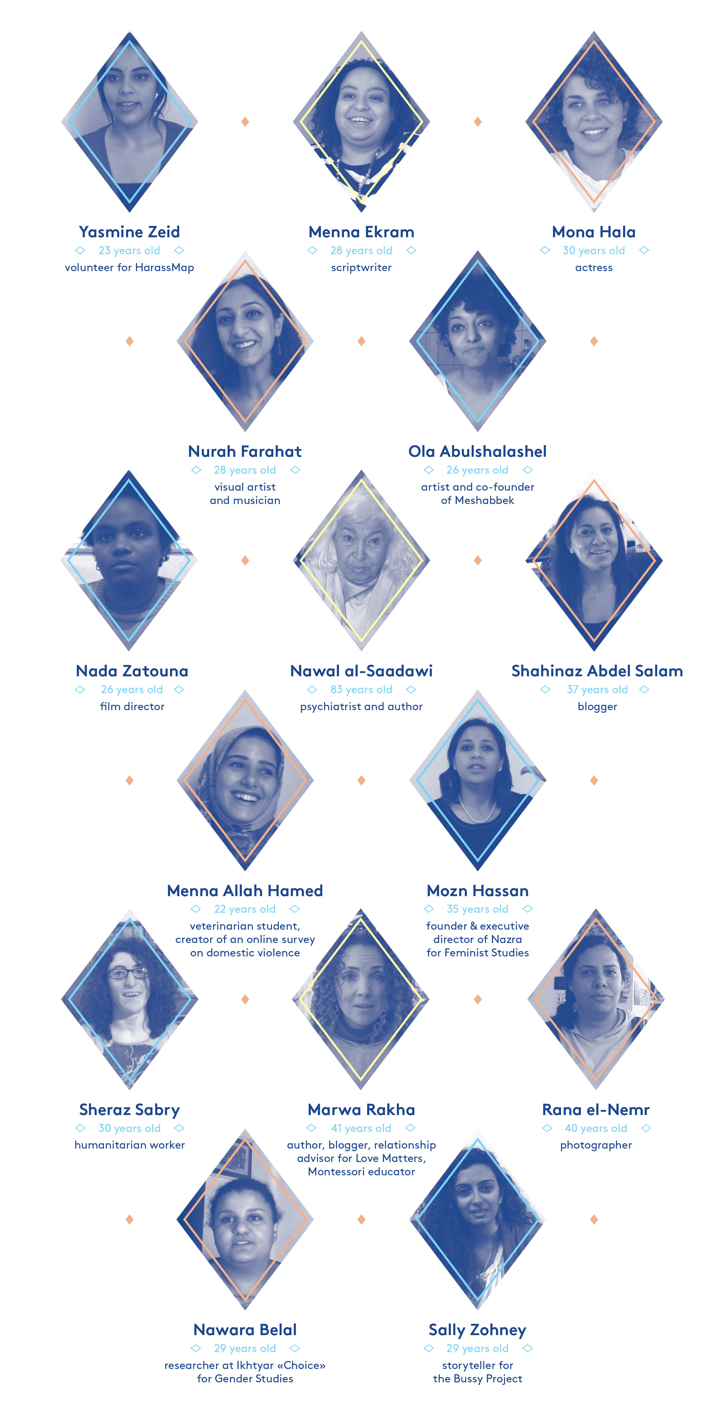
Our project does not seek to present "the Egyptian woman": the use of the singular often seems irrelevant on the subject of Womanhood... This is the panorama of one social group, active at a given point, in a chosen city. All speak fluent English and often use it in media communication or when evoking bodily (bawdy) themes. Our project does not illustrate Egypt’s sociological diversity, it is about this sole group engaged at one specific time engaged around one precise theme: Gender.
Yet this project is about professional diversity within this Gender sphere. It is also about the plurality of the individual paths which led each to this Gendered sphere and to Cairo.
لا يسعى مشروعنا أن يقدم “المرأة المصرية”: استخدام صيغة المفرد كثيرا ما تبدو في غير محلها بالنسبة لموضوع النسوية… هذه بانوراما لفئة اجتماعية واحدة، كانت نشطة في لحظة محددة في مدينة محددة. يتكلمون الإنجليزية بطلاقة ويستخدمونه في الإعلام أو عندما يتحدثون عن أمور الجسد (البذيئة). مشروعنا لا يظهر التنوع الاجتماعي في مصر، إنه عن مجموعة تشتبك مع موضوع محدد: الجندر.
ولكن هذا المشروع عن التنوع المهني في الدائرة المعنية بالجندر وهو أيضا عن تعدد الطرق الفردية التي أوصلت كل واحدة منهم لهذه الدائرة وللقاهرة.
How?
كيف؟
The Rules of the Game: One camera, no leading questions, and a refusal to impose the issues that yesterday’s and today’s Orientalism adore. Just a 75-word-list written together around Gender. No crew, no set, no special lights, no make up team, just an encounter with me, and the camera as our only witness.
In 2015, I met each of the participants in their homes, at their friends', or at their workplace, between Dokki, Shubra, Downtown, Mohandessin, Zamalek, and even Paris. I presented them individually with the list of words and directly started filming.
قواعد اللعبة: كاميرا واحدة، بلا أسئلة للتوجيه والامتناع عن فرض مواضيع يهواها استعمار الأمس والحاضر. لا شئ سوى قائمة لخمس وسبعون كلمة مكتوبة عن الجندر. بلا طاقم عمل أو استوديو أو إضاءة، بلا طاقم مكياج، فقط لقاء معي و الكاميرا شاهد عليه.
في عام ٢٠١٥، قابلت كل مشاركة في بيتها أو عند صديقتها أو في مكان عملها، بين شبرا والدقي والمهندسين والزمالك وحتى باريس. أعطيت كل منهن القائمة ثم بدأت التصوير على الفور.
The words, a participatory ABC:الكلمات، أبجدية تشاركية:
Most of the words that make up this list come from free exploratory interviews. The initial list was elaborated before filming. As mentioned previously, as early as 2012, I met 4 participants as part of an Anthropological research on women’s autobiographical writings and noticed the repetition of some key words.
Those words identified during this preliminary study were then presented, in 2015, to all of the 15 participants of our interactive documentary: they were asked to complete this list and to pick their words freely in order to talk about their chosen experiences, to evoke whatever they associated to them.
"Expected" words, that some media overemphasize, were avoided... Instead, a list of broader, more metaphorical terms was presented to them. In this ABC, you will find, among others, the following entries: Expectation, Journey, Desire, Experience, Reform, Stereotypes, Voice, etc.
Each woman discovered this list only while I was setting up the camera: no preparation, we wanted to record the immediate reaction. Every video lasts between 2 and 18 minutes. While editing, we didn't cut out any part of their streams of thought because personal rhythm and tone are part of the individual narrative.
معظم الكلمات في القائمة جاءت من مقابلات حرة استكشافية. القائمة الأولية تكونت قبل التصوير. كما أشرنا سابقا منذ ٢٠١٢ قابلت ٤ مشاركات كجزء من بحث أنثروبولوجى عن كتابة النساء للسيرة الذاتية ولاحظت تكرر بعض الكلمات الدليلية.
الكلمات التي حُددت في الدراسة الأولية قُدمت في ٢٠١٥ للمشاركات الخمسة عشر: طلب منهن تكملة القائمة وأن يخترن كلماتهن بحرية لكي يتحدثن عن تجاربهن لكي يثرن أي موضوع متعلق بهن.
تم تفادي بعض الكلمات “المتوقعة” التي يبرزها الإعلام بشكل زائد… بدلا من ذلك قدمت لهم قائمة من كلمات أوسع وأكثر مجازية. في هذه الأبجدية سوف تجدون كلمات من بينها: توقعات، رحلة، رغبة، تجربة، إصلاح، صور نمطية، صوت، إلخ.
كل امرأة اكتشفت القائمة وأنا أقوم بإعداد الكاميرا: بلا تحضير، أردنا أن نسجل رد الفعل الفوري. مدة الفيدوهات ما بين دقيقتان وثمانية عشر دقيقة. لم نقطع أي جزء من سيل أفكارهن في المونتاج، لأن الإيقاع الشخصي والنبرة جزء من السردية الفردية.
The kaleidoscope, an interactive encounter:الكاليدوسكوب، لقاء تفاعلي:
Every woman interviewed gave her definition of a first term. Throughout the interview, the words relate to each other, naturally. Browsing the website will allow visitors to find this fluidity of circulation between the concepts. Just like in a conversation, start with a subject, a theme, a word, and take the time to see where the person you're listening to takes it.
You will first enter this interactive kaleidoscope by clicking on the keyword of your choice.
Then, all the videos where this word is mentioned will appear. You will be able to explore different aspects of these world- views. It’s up to you to navigate through their lexical fields.
These encounters bring to question the notion of "otherness", but also, and above all, they bring to the forefront the "continuities" inherent to being a woman. If words like "Revolution" lead us to think of the national dynamics that shape daily life, in contrast, terms such as "Body" illustrate the global scope of the gendered problematics that they carry. The diversity of voices, and the multiplicity of perspectives involved here invite us to think about the complexity of womanhood in Cairopart and elsewhere.
كل امرأة أجرينا معها مقابلة أعطت تعريفها لكلمة أولية وخلال المقابلة تتصل الكلمات ببعضها بشكل طبيعي. سوف يتيح تصفح الموقع للزوار أن يجدوا السلاسة في التنقل ما بين المفاهيم كأنها محادثة، تبدأ بموضوع و كلمة و تأخذ الوقت لترى أين إلى أين سيأخذ المتكلم.
سوف تدخل الكاليدوسكوب التفاعلي عندما تضغط على الكلمة التي تختارونها.
ثم يظهر كل الفيديوهات التي ذكر فيها هذه الكلمة. سوف يتاح لكم استكشاف كل الجوانب المختلفة لتلك الرؤى للعالم لك حرية التحرك في مجالهن اللغوي.
اللقاءات تشكك في مفهوم “الآخر” وفوق ذلك تضع في المقدمة “الثوابت” المتأصلة في كينونة المرأة. إذا كانت كلمات مثل “ثورة” تقودنا للتفكير في ديناميكيات الوطنية التي تشكل الحياة اليومية وفي المقابل كلمات مثل “جسد” توضح النطاق العالمي للاشكاليات الجندرية المتضمنة بها. يدفعنا تنوع الأصوات وتعدد وجهات النظر للتفكير في تعقيد النسوية في القاهرة وأماكن أخرى.
Our Team
فريقنا
In order to understand the answers given on such a topic, it seemed part of the methodology to question my own "positionality" (Abu-Lughod 1988: 472), and the way this situation of utterance, this context has also shaped the participants' discourse, and therefore carved this project. Indeed, I do not wish to put an emphasis on my "I" as this project is about their ‘voices’, yet their perception of my "positionality" influenced the subjects they chose to bring up in reaction to it.
During my Master’s research in 2012 and while filming this project in 2015, the participants often asked about my own identity when meeting me in person. I answered stating the following information: I was born in Marseille. I’m French and I lived in Cairo as a child. Today I’m an Anthropology student in Paris. If asked about my origins I answered saying my grandparents were born in Algeria on my mother’s side, in Morocco and France on my father’s side. On the one hand my origins refer to the "situatedness" (Abu-Lughod 1988: 468) of my own standpoint and perspective. On the other, my nationality leads them to anticipate and expect a specific audience behind the future screen. When facing the lens of my camera, the participants knew that their videos would mainly be watched in French and English speaking countries by a wide range of people, in Egypt by specific spheres of people, and, thanks to the Internet, maybe worldwide by documentary viewers. They answered accordingly.
لكي أفهم الإجابات في شأن كهذا، بدا أن جزء من المنهج استجواب “موضعي” (ليلى أبو لغد ١٩٨٨: ٤٧٢) والطريقة التي شكل بها الموقف وقت الحديث والسياق شكل أيضا خطاب المشاركات وبالتالي شكل المشروع. أنا لا أريد أن أركز على “الأنا” لأن هذا المشروع عن “أصواتهن” ولكن إدراكهم “لموضعي” أثر على المواضيع التي اخترن طرحها.
خلال أبحاثي للماجستير في ٢٠١٢ وخلال تصوير هذا المشروع في ٢٠١٥ سألت المشاركات عن هويتي عندما قابلوني. كان إجابتي كما يلي: ولدت في مارسيليا. أنا فرنسية وعشت في القاهرة في طفولتي. الآن أنا طالبة في الأنثروبولوجي في باريس. عندما يسألونني عن أصولي كنت أجيب أن جدودي من أمي ولدوا في الجزائر وجدودي من أبي ولدوا في المغرب وفرنسا. على جانب الأول أصولي تشير إلى “تموضع” (ليلى أبو لغد ١٩٨٨: ٤٦٨) وجهة نظري وعلى الجانب الآخر جنسيتي تجعلهن يتوقعن جمهور الفيلم في المستقبل. عندما واجهن الكاميرا كانت المشاركات يعرفن أن المشاهدين سوف يكونوا في الأغلب في بلاد تتحدث الفرنسية الإنجليزية بالإضافة لدوائر محددة في مصر وبفضل الإنترنت جمهور الأفلام التسجيلية حول العالم. فكانت الردود على هذا الأساس.
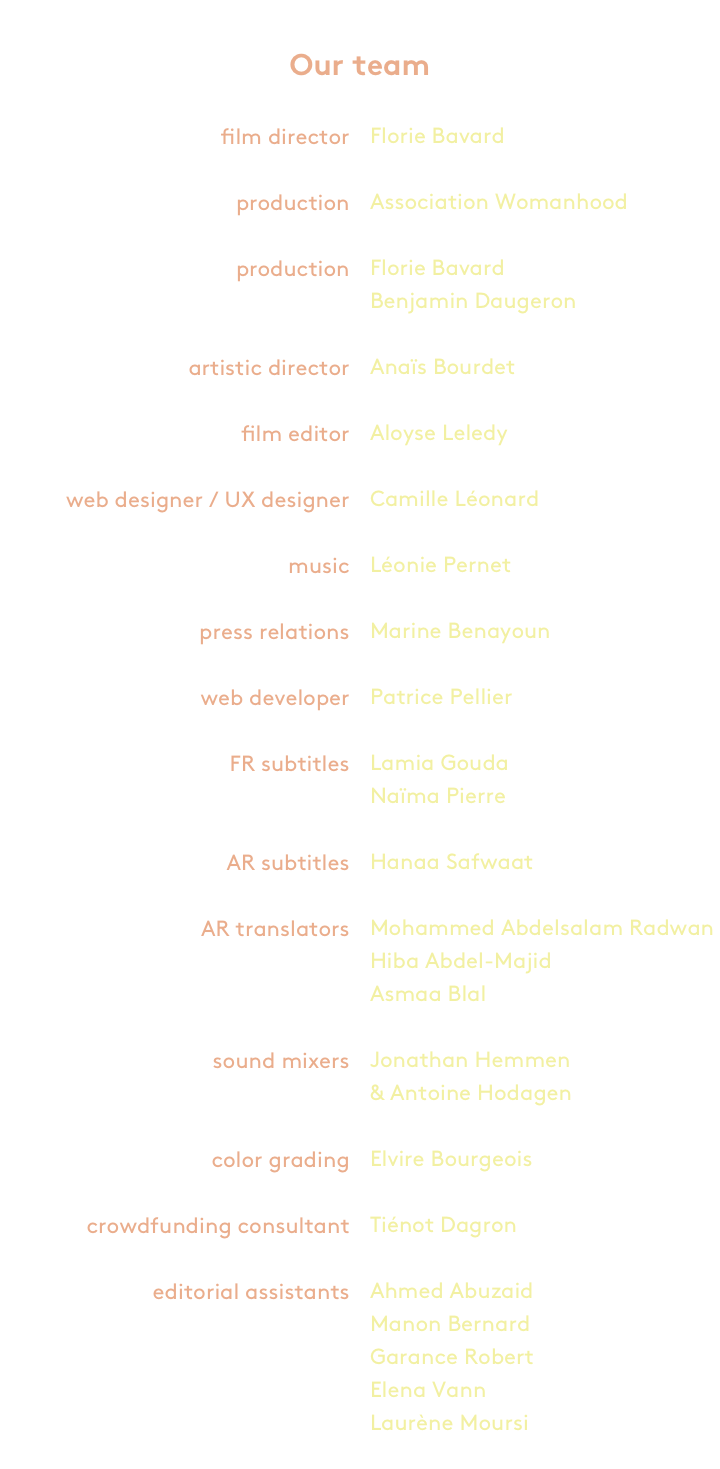
Returning to Paris with this footage, a post-production team gathered to give life and turn 7 hours of video into an interactive documentary. This became a collective project.
Our project is structured around our association: Womanhood, a non-profit association that carries out the functions of a production company. This full independence was an ethical contract that enabled us to build trust between the participants and us.
In order to keep this autonomy and fund such a project we turned towards a crowdfunding campaign. More than 300 people participated by donations and are in this way, also part of our team. We owe our independence to their trust.
This adventure is carried out by Benjamin Daugeron (co-producer) and myself (film director and co-producer), but it couldn’t have been done without the strong team that made it all possible. This is a Mediterranean project at a global scale: our team is partly French, party Egyptian. All live between Paris, Cairo, Istanbul, Buenos Aires, Lisbon, Addis Ababa. Skype challenged borders.
A big part of the team was already engaged in Gendered discussions, all were curious to discover and be part of an intersectional approach to feminism.
We hope that we can share with you this approach and invite all to a collective reflection on "intersectional womanhood" and sisterhood.
عند عودتي لفرنسا بالمشاهد المصورة، تجمع فريق ما بعد الإنتاج ليعطوا حياة لفيديو مدته سبع ساعات وحولوه لفيلم تسجيلي تفاعلي فأصبح مشروع جماعي.
مشروعنا مبني حول منظمتنا: نسوية. إنها منظمة غير هادفة للربح والتي تعمل كشركة إنتاج. أتاح لنا الاستقلال التام والذي أتاح لنا أن نبني ثقة بيننا وبين المشاركات.
لكي نحتفظ بهذه الاستقلالية وتمويل مشروع مثل هذا، اتجهنا لحملة تمويل جماعي. أكثر من ٣٠٠ شخص شاركوا بتبرعات ولذلك هم جزء من الفريق. استقلالنا كان بفضل ثقتهم.
شارك في هذه المغامرة بينجامين دوغرون (منتج) وأنا (مخرج ومنتج) ولكن ما كنا نتمكن من فعل ذلك دون فريق قوي الذي جعل كل شئ ممكنا. هذا المشروع متوسطي على نطاق واسع: فريقنا فرنسي ومصري، يعيشون بين باريس والقاهرة واسطنبول وبوينوس أيريس ولشبونة وأديس أبابا. السكايب يتحدى الحدود.
جزء كبير من الفريق كان يشارك بالفعل في نقاشات حول الجندر وكلهم كانوا فضوليين وأرادوا أن يكونوا جزء من نهج تقاطعي في النسوية.
نأمل أننا نستطيع أن نقدم لكم هذا النهج وندعوكم للتفكير الجماعي في “النسوية التقاطعية” والأخوية.
Florie Bavard
May 2017
